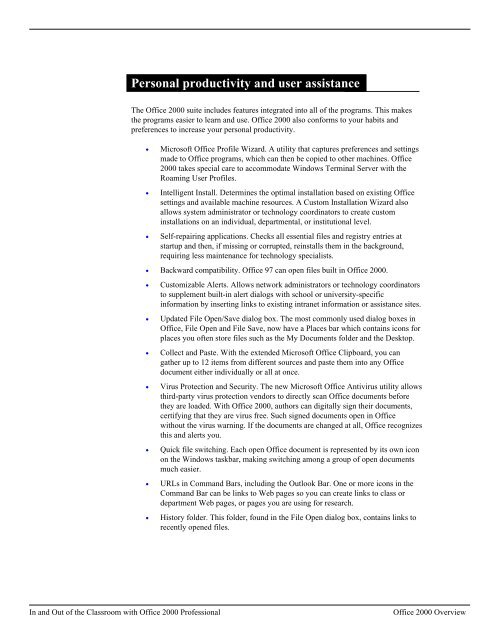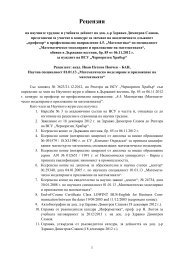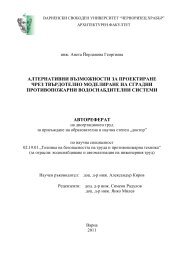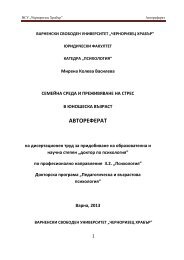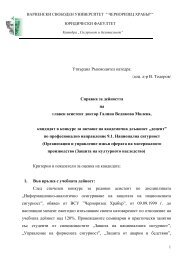MS Office 2000 Professional Overview
MS Office 2000 Professional Overview
MS Office 2000 Professional Overview
You also want an ePaper? Increase the reach of your titles
YUMPU automatically turns print PDFs into web optimized ePapers that Google loves.
Personal productivity and user assistance<br />
The <strong>Office</strong> <strong>2000</strong> suite includes features integrated into all of the programs. This makes<br />
the programs easier to learn and use. <strong>Office</strong> <strong>2000</strong> also conforms to your habits and<br />
preferences to increase your personal productivity.<br />
• Microsoft <strong>Office</strong> Profile Wizard. A utility that captures preferences and settings<br />
made to <strong>Office</strong> programs, which can then be copied to other machines. <strong>Office</strong><br />
<strong>2000</strong> takes special care to accommodate Windows Terminal Server with the<br />
Roaming User Profiles.<br />
• Intelligent Install. Determines the optimal installation based on existing <strong>Office</strong><br />
settings and available machine resources. A Custom Installation Wizard also<br />
allows system administrator or technology coordinators to create custom<br />
installations on an individual, departmental, or institutional level.<br />
• Self-repairing applications. Checks all essential files and registry entries at<br />
startup and then, if missing or corrupted, reinstalls them in the background,<br />
requiring less maintenance for technology specialists.<br />
• Backward compatibility. <strong>Office</strong> 97 can open files built in <strong>Office</strong> <strong>2000</strong>.<br />
• Customizable Alerts. Allows network administrators or technology coordinators<br />
to supplement built-in alert dialogs with school or university-specific<br />
information by inserting links to existing intranet information or assistance sites.<br />
• Updated File Open/Save dialog box. The most commonly used dialog boxes in<br />
<strong>Office</strong>, File Open and File Save, now have a Places bar which contains icons for<br />
places you often store files such as the My Documents folder and the Desktop.<br />
• Collect and Paste. With the extended Microsoft <strong>Office</strong> Clipboard, you can<br />
gather up to 12 items from different sources and paste them into any <strong>Office</strong><br />
document either individually or all at once.<br />
• Virus Protection and Security. The new Microsoft <strong>Office</strong> Antivirus utility allows<br />
third-party virus protection vendors to directly scan <strong>Office</strong> documents before<br />
they are loaded. With <strong>Office</strong> <strong>2000</strong>, authors can digitally sign their documents,<br />
certifying that they are virus free. Such signed documents open in <strong>Office</strong><br />
without the virus warning. If the documents are changed at all, <strong>Office</strong> recognizes<br />
this and alerts you.<br />
• Quick file switching. Each open <strong>Office</strong> document is represented by its own icon<br />
on the Windows taskbar, making switching among a group of open documents<br />
much easier.<br />
• URLs in Command Bars, including the Outlook Bar. One or more icons in the<br />
Command Bar can be links to Web pages so you can create links to class or<br />
department Web pages, or pages you are using for research.<br />
• History folder. This folder, found in the File Open dialog box, contains links to<br />
recently opened files.<br />
In and Out of the Classroom with <strong>Office</strong> <strong>2000</strong> <strong>Professional</strong><br />
<strong>Office</strong> <strong>2000</strong> <strong>Overview</strong>


